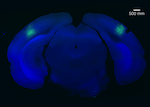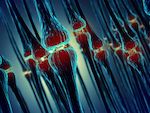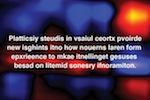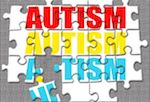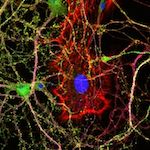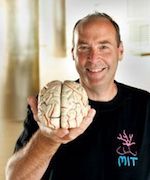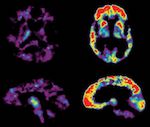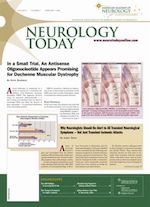In the News
Shaping the Brain: Experience-Dependent Plasticity in Development, Learning and Memory
from Azo Life Sciences
In this Thought Leaders interview Mark Bear, the Picower Professor of Neuroscience at MIT, delves into his pioneering work that has transformed our understanding of how experiences shape the brain.
Mark Bear on Mind & Matter Podcast
Nick Jikomes and Dr. Bear discuss: the visual system in the brain, from the retina to visual cortex; critical periods of brain development; mechanisms of neuroplasticity; metaplasticity; amblyopia and visual impairments; ketamine & psychedelics; and more.
Society for Neuroscience 2023 Outstanding Career and Research Achievements
from the Society for Neuroscience
Mark Bear has received the 2023 Julius Axelrod Prize, which honors scientists with distinguished achievements in the broad field of neuropharmacology or a related area and exemplary efforts in mentoring young scientists.
Resolving a seeming contradiction, study advances understanding of visual recognition memory
Hayden et al. (2023) covered in Picower Research Findings
Scientists have invested decades in piecing together how our vision is so good at recognizing what’s familiar. A new study overcomes an apparent discrepancy in data to reveal a new insight into how it works.
Retraining the Brain for Better Vision
covered in Faculty Features by the MIT Industrial Liaison Program
Amblyopia is one striking example of how the brain is modified by experience, says Mark Bear, a neuroscientist at MIT's Picower Institute for Learning and Memory. His research focuses on this phenomenon of brain plasticity, with particular attention to the synapses that connect neurons in the brain.
Bear Elected Member of National Academy of Medicine
covered in Picower People
The National Academy of Medicine announced October 17 that its members have elected Mark Bear, Picower Professor of Neuroscience in The Picower Institute for Learning and Memory, to join their esteemed ranks. Election to the Academy is considered one of the highest honors in the fields of health and medicine.
In deep water with Gül Dölen
covered in Spectrum News
As an M.D./Ph.D. student in Mark Bear’s lab, first at Brown University in Providence, Rhode Island, and then at the Massachusetts Institute of Technology in Cambridge, Dölen arrived so full of new research ideas that Bear’s main goal was to rein her in... She began work on fragile X syndrome in mice.
Study shows fragile X treatment can incur resistance, suggests ways around it
Stoppel et al. (2021) covered in Picower Research Findings
While the brain acquires resistance to continuous treatment with mGluR5 inhibitor drugs, lasting effects may still arise if dosing occurs intermittently and during a developmental critical period.
If You're Brave Enough — An Injection Of Pufferfish Toxin Could Treat 'Lazy Eye'
Fong et al. (2021) previewed in NPR
The visual impairment known as "lazy eye" can be treated in kids by covering their other eye with a patch. Scientists may have found a way to treat adults with the condition using a pufferfish toxin.
Prof. Mark Bear, Professor of Neuroscience at Massachusetts Institute of Technology. Scientific Sense
from Scientific Sense
Prof. Mark Bear is a Professor of Neuroscience in The Picower Institute for Learning and Memory and the Department of Brain and Cognitive Sciences at Massachusetts Institute of Technology. His laboratory is interested in how the brain is modified by experience. He uses a variety of methods to examine the synaptic modifications that form the neurobiological basis of learning and memory.
Selective enzyme blocker eases fragile X traits in mice
McCamphill et al. (2020) covered in Spectrum News
An experimental drug prevents seizures and improves memory in a mouse model of fragile X syndrome, according to a new study1. The drug selectively blocks an enzyme that is overactive in the brains of people with fragile X and could offer a potential treatment for the condition.
Findings weaken notion that size equals strength for neural connections
Thomazeau et al. (2020) covered in MIT News
Scientists have studied this “synaptic plasticity” for decades, but a new study by researchers at MIT’s Picower Institute for Learning and Memory highlights several surprises about some of the basic mechanisms by which it happens. Getting to the bottom of what underlies some of those surprises, the research further suggests, could yield new treatments for a disorder called Fragile X that causes autism.
Scientists find a new way to reverse symptoms of Fragile X
McCamphill et al. (2020) covered in MIT News
MIT scientists have identified a potential new strategy for treating Fragile X syndrome, a disorder that is the leading heritable cause of intellectual disability and autism.
Science On Screen Presents: Dr. Mark Bear
a talk at the Martha's Vineyard Film Society
Dr. Mark Bear discusses the feasibility of a "neuralyzer" as seen in the Men In Black films to the Martha's Vineyard Film Society as part of their Science On Screen series.
Study probing visual memory and amblyopia unveils many-layered mystery
Fong et al. (2019) covered in MIT News
Heading into the experiments described in a new paper in Cerebral Cortex, Bear and his team expected to confirm that key proteins called NMDA receptors act specifically in neurons in layer 4 of the visual cortex to make the circuit connection changes, or “plasticity,” necessary for both visual recognition memory and amblyopia. Instead, the study has produced unexpectedly divergent results.
Supporting students in Puerto Rico after a hurricane’s devastation
covered in MIT News
When Hurricane Maria hit Puerto Rico in September 2017, Héctor De Jesús-Cortés was vacationing on the island with his wife, Edmarie Guzmán-Vélez. In the days immediately after the hurricane, both focused on helping their families get their bearings; after that first week, however, they were itching to do more. That itch would take them to San Juan, Puerto Rico’s capital, where they asked the then-secretary of education a simple question: “How can we help?”
ARVO Spotlight on Members: Beckman-Argyros Award advances Mark Bear’s synaptic plasticity research studies
from ARVONews
The Arnold and Mabel Beckman Foundation selected Mark F. Bear, PhD, to receive the 2018 award for his research on the fundamental mechanisms of synaptic plasticity in the brain, the synaptic and molecular basis for the effects of monocular deprivation and patch therapy, and the role of experience-dependent synaptic plasticity in learning, memory and neurorehabilitation.
Biotechs compete against each other for a common cause
from the Boston Globe
Teams representing 42 Boston-area biotechs went head to head in lawn games such as cornhole and ladder golf at the first annual FRAXA Biotech Games on Thursday. The event raised more than $30,000 for research at the Massachusetts Institute of Technology Bear Lab, according to organizer Dave Bjork of the FRAXA Research Foundation, a nonprofit that aims to cure Fragile X syndrome.
Beckman Foundation Names Mark Bear, Ph.D., of the Massachusetts Institute of Technology as 2018 Beckman-Argyros Vision Research Award Winner
from the Arnold and Mabel Beckman Foundation
The Arnold and Mabel Beckman Foundation today announced its 2018 Beckman-Argyros Vision Research Award winner is Dr. Mark Bear, Picower Professor of Neuroscience at the Massachusetts Institute of Technology.…
Antidepressant restores youthful flexibility to aging inhibitory neurons
Eavri et al. (2018) in Science Daily
A new study provides fresh evidence that the decline in the capacity of brain cells to change, called "plasticity," rather than a decline in total cell number may underlie some of the sensory and cognitive declines associated with normal brain aging.…
Promise seen in possible treatment for autism spectrum disorder
Stoppel et al. (2018) covered in MIT News
Research from the laboratories of Mark Bear at MIT and Jacqueline Crawley at the University of California at Davis, has identified a potential therapeutic for ASD. Researchers found that R-Baclofen reverses cognitive deficits and improves social interactions in two lines of 16p11.2 deletion mice…
Youthful plasticity restored to brains of adult mice
Jenks et al. (2017) covered in ScienceDaily
Like much of the rest of the body, the brain loses flexibility with age, impacting the ability to learn, remember, and adapt. Now, scientists at University of Utah Health report they can rejuvenate the plasticity of the mouse brain, specifically in the visual cortex, increasing its ability to change in response to experience…
Creating new treatments for amblyopia
Fong et al. (2016) covered in MIT News
The visual system can be “rebooted,” offering hope for restoring sight to the visually impaired, according to research at MIT…
MIT researchers find where visual memories are made
Cooke et al. (2015) covered in MIT News
In findings that may lead to new treatments for cognitive disorders, researchers at MIT’s Picower Institute for Learning and Memory zero in on how the brain forms memories of what has been seen…
Drug abates symptoms in two genetic models of autism
Tian et al. (2015) highlighted in SFARI News
Drugs developed to treat fragile X syndrome may also work for autism because both disorders feature defects at neuronal junctions, or synapses, suggests a paper published 12 January in Nature Neuroscience…
New findings reveal genetic brain disorders converge at the synapse
Tian et al. (2015) covered in MIT News
Picower Institute researchers show that different causes of autism and intellectual disability respond to the same treatment…
[VIDEO] Restoring Brain Functions: Recovery from Genetic and Environmental Adversity
New Respect for Primary Visual Cortex
Gavornik & Bear (2014) covered in MIT News
In the context of learning and memory, the primary visual cortex is the Rodney Dangerfield of cortical areas: It gets no respect. Also known as “V1,” this brain region is the very first place where information from the retina arrives in the cerebral cortex…
Statins for Fragile X
Osterweil et al. (2013) highlighted in Nature Science-Business eXchange (SciBX)
Researchers at the Massachusetts Institute of Technology have mouse data showing that the cholesterol drug lovastatin can correct fragile X syndrome. The findings add to a growing list of unconventional strategies for treating this common form of mental retardation…
Neurodevelopmental disorders: Lovastatin as fragile X therapy
Osterweil et al. (2013) highlighted in Nature Reviews Neuroscience
Fragile X syndrome (FXS) is caused by loss of the fragile X mental retardation 1 gene product, a repressor of mRNA translation. It is thought that excessive protein synthesis downstream of metabotropic glutamate receptor 5 activation leads to…
Fragile X Syndrome Therapeutics: Translation, Meet Translational Medicine
Osterweil et al. (2013) previewed in Neuron
Fragile X syndrome, a common cause of intellectual disability and autism, is thought to occur due to abnormal regulation of neuronal protein synthesis. A study by Osterweil et al. (2013)), in this issue, demonstrates that the HMG-CoA reductase inhibitor lovastatin can normalize protein synthesis and also reduce audiogenic seizures in Fmr1 knockout mice…
Arbaclofen Shows Promise for Treating Core Symptoms of Autism
Berry-Kravis et al. (2012) and Henderson et al. (2012) highlighted in Autism Speaks
Currently there are no medicines to treat autism’s core symptoms of impaired social and communication abilities and repetitive behaviors. This year, two studies – a clinical trial of patients with fragile X syndrome and a mouse study – suggest that arbaclofen could become the first…
Drug Improves Social Deficits in Fragile X Syndrome
Berry-Kravis et al. (2012) and Henderson et al. (2012) highlighted in Simons Foundation notable papers of 2012
A drug called arbaclofen improves behavioral problems in people with fragile X syndrome, an inherited condition that can lead to mental retardation and autism, according to the results of a clinical trial published today in Science Translational Medicine…
Progress Made On Drug for Austism Symptoms
Fragile X therapeutics research covered by NPR (2012)
An experimental drug that helps people who have Fragile X syndrome is raising hopes of a treatment for autism. The drug, called arbaclofen, made people with Fragile X less likely to avoid social interactions, according to a study in Science Translational Medicine. Researchers suspect it might do the same for people with autism…
[PDF] Special Report: New drugs, fresh hope for autism patients
Chronic Pharmacological mGlu5 Inhibition Corrects Fragile X in Adult Mice
Michelon et al. (2012) evaluated by Faculty of 1000
This is a landmark study demonstrating that chronic inhibition of metabotropic glutamate receptor 5 (mGluR5) reverses established phenotypes in a Fragile X syndrome mouse model. Using a new, potent, selective, orally available mGluR5 inhibitor, CTEP, with favorable pharmacokinetics and long half life…
Could autism be reversed with a pill?
Michelon et al. (2012) previewed in The Boston Globe
What if autism could be reversed with a pill? -- A growing body of research in mice and a handful of people are finding that autism is not a degenerative disease like Alzheimer’s, but a changeable condition, like, say, epilepsy that can potentially be controlled…
Fragile X Syndrome Therapeutics S(C)TEP through the Developmental Window
Michelon et al. (2012) previewed in Neuron
Treatment for fragile X syndrome and related autism spectrum disorders has long been thought to be effective only during a narrow window early in development. In this issue of Neuron, Michalon et al. (2012)) dispel this myth…
[VIDEO] Cortical Synaptic Plasticity: From Amblyopia to Autism
Vernon Mountcastle Lecture at Johns Hopkins University (2012)
Tuberous Sclerosis, Fragile X May Be Molecular Opposites
Auerbach et al. (2011) highlighted in Simons Foundation notable papers of 2011
Some forms of autism are caused by too many proteins at the synapse, the junction between neurons, whereas other forms result from too few, according to a study published 23 November in Nature. The findings suggest that drugs that effectively treat people with one form of autism may not help, and may even harm, individuals with another form…
Neurodevelopmental Disorders: A Fragile Synaptic Balance
Auerbach et al. (2011) covered in Nature Reviews Neuroscience
A number of specific gene mutations are associated with intellectual disability and autism, providing hope that understanding common downstream effects might shed light on the pathophysiology of autism spectrum disorders. Bear and colleagues now show that…
Mutations Causing Syndromic Autism Define an Axis of Synaptic Pathophysiology
Auerbach et al. (2011) evaluated by Faculty of 1000
In a clear and elegant study, Auerbach et al. demonstrate that two genetic mutations implicated in syndromic autism, TSC2+/- and Fmr1-/y, modulate metabotropic glutamate receptor 5 (mGluR5)-signaling in opposite directions, and that coexpression of these mutations cancel out both the physiological and…
A New Piece to the Autism Puzzle
Auerbach et al. (2011) covered in MIT News
Most cases of autism are not caused by a single genetic mutation. However, several disorders with autism-like symptoms, including the rare Fragile X syndrome, can be traced to a specific mutation. Several years ago, MIT neuroscientist Mark Bear discovered that…
Mimicking the Brain, in Silicon
Rachmuth et al. (2011) covered in MIT News
For decades, scientists have dreamed of building computer systems that could replicate the human brain’s talent for learning new tasks. MIT researchers have now taken a major step toward that goal by designing a computer chip that mimics how the brain’s neurons adapt in response to new information…
[VIDEO] Autism treatments and the case of Fragile X: Dr. Mark Bear's address to Congress
Address to Congressional Research Caucus posted by FRAXA (2011)
[VIDEO] Early Explorations of the Visual Cortex
Special symposium with David Hubel and Torsten Wiesel (2011)
New Version of an Old Drug Could Treat Autism (and Addiction Too)
Fragile X Special Report: Accelerating the CNS Cycle
Matthew's Liberation: Seaside at Forefront of New Approach to Fragile X
Seaside Therapeutics' Fragile X research covered in The Boston Globe (2010)
[VIDEO] Fulfilling the Promise of Molecular Medicine in a Developmental Brain Disorder
Promise Seen in Drug for Retardation Syndrome
A Change of Mind
McCurry et al. (2010) covered in MIT News
MIT neuroscientists have now found that a single protein, known as Arc, appears to control neurons’ ability to strengthen and weaken their synapses by regulating the number of neurotransmitter receptors on their surfaces. The finding could help researchers identify new drug targets…
Frontiers of Medicine: Radical Cures - Reversing Autism
Autism and Fragile X research covered in Popular Science (2010)
Recovery from monocular deprivation using binocular deprivation
Blais et al. (2008) evaluated by Faculty of 1000
This paper is particularly interesting, in that it argues that recovery from deprivation can be accomplished by matching the activity to the two eyes, even with low quality vision, as through a closed eyelid (though high quality vision would work too, as shown by other studies…
[AUDIO] Drugs Hint At Potential Reversal Of Autism
Cannabinoid receptor blockade reveals parallel plasticity mechanisms in different layers of mouse visual cortex
Liu et al. (2008) evaluated by Faculty of 1000
The authors demonstrate that ocular dominance plasticity in layer 4 of mouse visual cortex can be dissociated from that of layers 2/3, despite the current view that the thalamocortical input layer 4 depended in this respect on the upper layers…
Study Suggests Caution on New Anti-Obesity Drug in Kids
Liu et al. (2008) covered in MIT News
Anti-obesity drugs that work by blocking brain molecules similar to those in marijuana could also interfere with neural development in young children, according to a new study from MIT's Picower Institute for Learning and Memory…
Correction of fragile X syndrome in mice
Dölen et al. (2007) evaluated by Faculty of 1000
This is a clever, direct examination of the hypothesis that Fragile X Syndrome is due, at least in part, to overactivation of metabotropic glutamate receptor-dependent signaling. The authors crossed knockout mice lacking Fmr1, the human homolog of the fragile X mental retardation protein, with…
Inherited Retardation, Autism Corrected in Mice
Dölen et al. (2007) covered in MIT TechTalk
Researchers at MIT’s Picower Institute for Learning and Memory have corrected key symptoms of mental retardation and autism in mice…
Discovery Points to Treatment Approach for Fragile X Syndrome
Dölen et al. (2007) covered in HHMI News
New research has found that many of the symptoms of fragile X syndrome, the most common cause of inherited mental retardation, can be eliminated in mice by reducing the expression of a single gene in the brain…
MIT Corrects Inherited Retardation, Autism in Mice
Dölen et al. (2007) covered in MIT News
Researchers at MIT's Picower Institute for Learning and Memory have corrected key symptoms of mental retardation and autism in mice. The work, which will be reported in the Dec. 20 issue of Neuron, indicates that a certain class of drugs could have the same effect in humans…
Big MIT Contingent at Society for Neuroscience Meeting
Special Lecture at SFN Annual Meeting covered in MIT News (2007)
Glutamate Blockade Corrects Fragile X Syndrome in Mice, Human Trials Are Planned
Dölen et al. (2007) covered in Neurology Today
In mice, preventing one form of glutamate signaling corrects almost all the features of Fragile X syndrome (FXS), according to a Dec. 20 study in Neuron. The findings support a unifying theory of FXS pathogenesis, and pave the way for clinical trials perhaps as soon as the end of this year…
Neuroscience Professor Named New Picower Institute Director
Appointment of director of the Picower Institute covered in The Tech (2007)
Mark Bear Named Picower Director
Appointment of director of the Picower Institute covered in TechTalk (2007)
Mark Bear Named Picower Director
Appointment of director of the Picower Institute covered in MIT News (2007)
Learning induces long-term potentiation in the hippocampus
Whitlock et al. (2006) evaluated by Faculty of 1000
This seminal paper presents a missing link: the learning-induced occurrence of long-term potentiation (LTP) in the hippocampus, which was expected to exist but could not be shown before. The important 'trick' in this study was the use of a single trial hippocampus-dependent learning task (inhibitory avoidance task)…
Clues to Making and Breaking Memories Included in List of Year’s Top Science
Whitlock et al. (2006) covered in NIMH Science News
NIMH-funded researchers were cited in Science Magazine’s December 2006 “Breakthrough of the Year” special issue. The most recent top 10 list of discoveries included major advances in understanding how memories are formed and stored, which may help scientists to develop treatments for many types of mental disorders…
The Runners-Up: 9 - The Persistence of Memory
Whitlock et al. (2006) named one of 10 breakthroughs of the year in Science (2006)
How the brain records new memories is a central question in neuroscience. One attractive possibility involves a process called longterm potentiation (LTP) that strengthens connections between neurons. Many neuroscientists suspect that LTP is a memory mechanism, but proving it hasn't been easy. Several findings reported this year strongly bolstered the case…
Pick Your Own Memories?
Whitlock et al. (2006) covered in The Boston Globe
A rat scurries into the dark half of a cage. Ouch! The floor is electrified. Minutes later, Massachusetts Institute of Technology scientists detect the formation of a memory of that painful event -- that floor over there hurt! -- in the animal's brain…
MIT Provides First Evidence for Learning Mechanism
Whitlock et al. (2006) covered in MIT News
Finally confirming a fact that remained unproven for more than 30 years, researchers at MIT's Picower Institute for Learning and Memory report in the Aug. 25 issue of Science that certain key connections among neurons get stronger when we learn…
Reward Timing in the Primary Visual Cortex
Shuler & Bear (2006) evaluated by Faculty of 1000
This is the first observation that rewarded behavior can change the firing pattern of neurons in V1, the first area in the cortex in which visual information is processed. These data suggest that sensory information can be modulated by behavioral experience very early during sensory processing…
[Video] The Ups and Downs of Ocular Dominance Plasticity in Visual Cortex
Scientists Target X Factor in Retardation Research
Fragile X research covered in the Boston Business Journal (2004)













